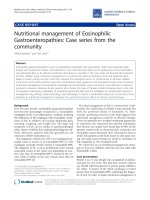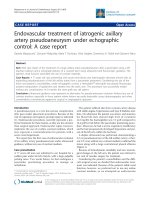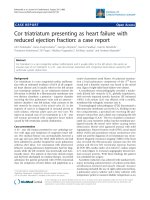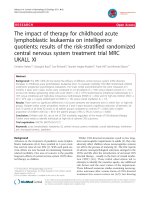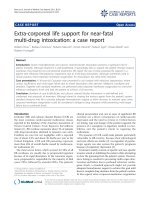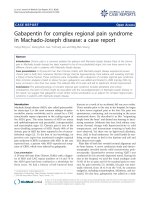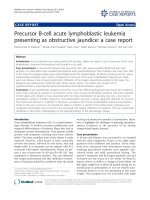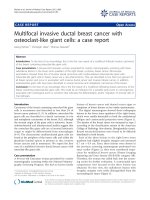Báo cáo y học: "The management of acute parathyroid crisis secondary to parathyroid carcinoma: a case report" pdf
Bạn đang xem bản rút gọn của tài liệu. Xem và tải ngay bản đầy đủ của tài liệu tại đây (1.2 MB, 5 trang )
CASE REPO R T Open Access
The management of acute parathyroid crisis
secondary to parathyroid carcinoma:
a case report
Kathy Rock
*
, Nariman Fattah, Diarmuid O’Malley, Enda McDermott
Abstract
Introduction: Hypercalcaemic hyperparathyroid crisis is a rare but life-threatening complication of primary
hyperparathyroidism. Parathyroid carcinoma is a rare malignancy with an incidence of 0.5% to 4% of all reported
cases of primary hyperparathyroidism.
Case presentation: We report the case of a 60-year-old Caucasian man with hypercalcaemic hyperpa rathyroid
crisis associated with parathyroid carcinoma. He presented with a classic hypercalcaemic syndrome and his serum
calcium and parathyroid hormone levels were at 4.65 mmol/L and 1743 ng/L, respectively. He initially presented
with a two-week history of weakness and lethargy and a one-week history of vomiting, polyuria and polydipsia. An
emergency left thyroid lobectomy and left lower parathyroidectomy were performed. There was a prompt
decrease in his parathyroid hormone level immediately after surgery. Histology revealed that our patient had a 4-
cm parathyroid carcinoma.
Conclusion: In patients with parathyroid carcinoma, the optimal surgical treatment is en bloc resection with
ipsilateral thyroid lobectomy and removal of any enlarged or abnormal lymph nodes. Surgery is the only curative
treatment. In our patient, prompt surgical intervention proved successful. At six months the patient is well with no
evidence of disease recurrence. This case highlights the importance of considering a hyperparathyroid storm in the
context of a parathyroid carcinoma. Parath yroid carcinoma is a rare entity and our knowledge is mainly derived
from case reports and retrospective studies. This case report increases awareness of this serious and life-th reatening
complication. This report also illustrates how prompt and appropriate management provides the best outcome for
the patient.
Introduction
Hypercalcaemic hyperparathyroid crisis is a rare but life-
threatening complication of primary hyperparathyroid-
ism. The symptoms of hypercalcaemia are frequently
non-specific and reflect multi-organ involvement. This
condition should be suspected in acutely ill patients
with profound dehydration, gastrointestinal manifesta-
tions, urinary symptoms, altered mental state, or cardiac
arrhythmias. Parathyroid carcinoma is a rare malignancy
with an incidence of 0.5% to 4% of reported cases of pri-
mary hyperparathyroidism [1,2].
In patients with parathyroid carcinoma, the optimal
surgical treatment is en bloc resection with ipsilateral
thyroid lobectomy and the removal of any enlarged or
abnormal lymph nodes [3]. Surgery is the only curative
treatment. The cure rate is reported as being as high as
98% [4].
Case presentation
A 60-year-old Caucasian man was transferred from a
regional hospital to a tertiary referral centre for the
emergency management of hypercalcaemic hyperpar-
athyroid crisis. He initially presented with a two-week
history of weakness and lethargy and a one-week history
of vomiting, polyur ia and polydi psia. He became acutely
confused in the 24 hours prior to his admission to our
hospital and registered 12 on the Glasgow Coma Scale.
On examination he was normotensive with a regular
pulse of 70 beats per minute. There was a left-sided
* Correspondence:
Surgical Professorial Unit, Saint Vincent’s University Hospital, Dublin 4, Ireland
Rock et al. Journal of Medical Case Reports 2010, 4:28
/>JOURNAL OF MEDICAL
CASE REPORTS
© 2010 Rock et al; licensee BioMed Central Ltd. This is an Open Access article distributed under the terms of the Creative Commons
Attribution License ( g/licenses/by/2.0), which permits unrestricted use, distribution, and reproduction in
any medium, provided the original work is properly cited.
mass in the anterior triangle of his neck measuring 3 ×
3 cm. The mass was firm, regular, non-tender and
mobile. See Figure 1 and Tab le1 for results of the initial
laboratory investigations.
An ultrasonography of his neck showed a 4 × 3 cm
large cyst in the left lobe of his thyroid gland. His para-
thyroid glands were not visualised. A 99 mTc-sestamibi
scintigraphy scan was performed, and no evidence of a
parathyroid adenoma was found. An electrocardiogram
revealed acute changes with ST depression in leads II,
III, aVF and V2 to V6. An echocardiogram showed
good left ventricular failure (LVF) with an ejection frac-
tion of 63%.
Initial management included aggressive fluid resuscita-
tion, car diac monitoring and the administration of intra-
venous bisphosphonates. A left thyroid lobectomy and
left lower parathyroidectomy were performed. At the
time of o peration, a haemorrhagic cyst wit h a parat hyr-
oid gland within it was visualised. A biopsy was taken
from the left upper parathyroid gland. Histology
revealed a 4 cm parathyroid carcinoma within the cyst
which was fully excised. The cyst had a macroscopic
measurement of 6 × 6 × 5 cm. The wall of the cyst con-
tained a well-circumscribed, unencapsulated soft tissue
mass measuring 4 × 2.5 × 0.7 cm. It was light yellow-
tan in colour and firm in consistency. There was a small
amount of normal thyroid parenchyma within the speci-
men. The biopsy of the left upper parathyroid gland
revealed normal parathyroid parenchyma without diag-
nostic abnormality.
Our patient remained intubated and ve ntilated over-
night in the intensive care unit. His metabolic labora-
tory profile resolved quicklyfollowingthesurgery
[Figure2,Figure3,Figure4].Alowerrespiratorytract
infection delayed his initial recovery. He was dis-
charged home on oral calcium supplementation 24
days after surgery. He has been followed up for 6
months so far without any complications or disease
recurrence.
Discussion
In 1850, Sir Richard Owen was the first t o describe the
parathyroid glands after performing an autopsy of an
Indian rhinoceros. The first parathyroid surgery was
undertaken by Felix Mandl in Vienna in 1925.
Parathyroid carcinoma is a rare malignancy with an
incidenceof0.5%to4%inpatientswithprimary
Figure 1 Parathyroid carcinoma × 4.
Table 1 Results of the initial laboratory investigations
Investigation Test Result Reference range
FBC HB 10.5 g/l 13-18 g/l
Haematocrit 0.26 0.4-0.54
Platelets 388 10 × 9/l 150-400 10 × 9/l
WCC 23.3 2.20-2.60
Renal function Urea 29.2 mmol/l 2.1-7.1 mmol/l
Creatinine 309 μmol/l 62-106 μmol/l
Troponin 4.64 0.00-0.03
CK 653 U/l 1-185 U/l
Metabolic profile PTH 1743 ng/l 12-64 ng/l
Serum Calcium 4.65 mmol/l 2.20-2.60 mmol/l
Ionised Calcium 2.16 mmol/l 1.19-1.35 mmol/l
Liver function tests Alkaline 97 U/l 35-129 U/l
Phosphatase 57 U/l 8-61 U/l
GGT 27 g/l 25-50 g/l
Albumin
INR (ratio)
1.05
Electrolytes Sodium 133 mmol/l 135-145 mmol/l
Potassium 3.4 mmol/l 3.5-5.0 mmol/l
Rock et al. Journal of Medical Case Reports 2010, 4:28
/>Page 2 of 5
hyperparathyroidism. The clinical presentation of para-
thyroid carcinomas and adenomas can be very similar,
although patients with parathyroid carcinoma register
significantly higher serum calcium, parathyroid hormone
(PTH) and alkaline phosphatase levels compared with
patients with adenomas (see Table2). A palpable neck
mass has been reported in 30% to 76% of patients with
parathyroid carcinoma. This important clinical finding
constitutes a difference between benign and malignant
parathyroi d diseases, as a palpab le neck mass is dis-
tinctly unusual in primary h yperparathyroidism [5]. In
addition, recurrent laryngeal nerve palsy in a patient
with primary hyper parathyroidism who has not had any
previous neck surgery is also very suggestive of para-
thyroid cancer.
Our knowledge of this rare conditi on is based on case
reports and retrospective studies. One centre affiliated
to the University of Crete reported five cases of sporadic
Figure 2 Parathyroid carcinoma × 20.
Figure 3 Parathyroid carcinoma × 100.
Rock et al. Journal of Medical Case Reports 2010, 4:28
/>Page 3 of 5
parathyroid carcinoma over a 12-year period. The clini -
cal presentation of the disease in these five patients was
varied. The imaging modalities utilised in these patients
were ultrasonography, Sestamibi scan and computed
tomograph y (CT), all of which were able to locate para-
thyroid carcinoma in the patients. Four lesions were
localized using ult rasonography and Sestamibi scan and
one by CT. This case series highlighted the need for a
high index of clinical suspicion to allow for prompt sur-
gical intervention. It also highlighted the importance of
initial surgical management, as prognosis can depend on
the success of the first operation. It is also important to
remember the serious malignant potential of this lesion
at the time of resection [6].
There are many different modalities for the preopera-
tive localization of the parat hyroid lesions. In our patient,
a Sestamibi scan was preformed. In several centres, CT is
preformed in patients with parathyroidism as it allows
for improved preoperative planning for directed para-
thyroi dectomy with a four-dimensional CT. CT is able to
depict hyperfunctioning glands and to search for metas-
tasis and abnormal lymph glands. Four-dimensional CT
is a unique tool that allows for a precise preoperative
localization of hyperfunctioning parathyroid glands [7].
In cases of pr imary hyperthyr oidism, surgica l explora-
tion of the neck and resection of the hyperfunctioning
parathyroid tissue should be undertaken without further
delay (within 72 hours). Parathyroidectomy by an
experienced surgeon usually has a low complication rate
(2.3%) and results in the patient’s prompt recovery. The
cure rate is reported as being as high as 98% [8].
In patients with parathyroid carcinoma, the optimal
surgical treatment is en bloc resection with ipsilateral
thyroid lobectomy and the removal of any enlarged or
abnormal lymph nodes. Initial appropriate and aggres-
sive resection can help reduce local and distant recur-
rence [9]. Care must be taken intraoperatively to avoid
rupture of the tumour as the risk of local seeding is
high [10,11]. The management of the recurrent laryngeal
nerve is controversial. It should only be resected if there
is evidence of tumour inv olvement or if it is not func-
tioning preoperatively [12].
A decline in serum calcium should be expected in the
first 24-hour postoperative period. The half-life of PTH
is so short that the serum PTH level falls within min-
utes of successful surgery. Our patient’sPTHlevelfell
from 1743 ng/L preoperatively to 59.3 ng/L in the
immediate postoperative period. The clinical course of
this particular malignancy can be highly variable. Persis-
tent or recurrent disease can occur in up to 50% of
cases, while some patients are completely disease-free
after the initial surgery. This contributes to the
Figure 4 Parathyroid carcinoma lymphovascular invasion.
Table 2 Preoperative and postoperative courses of serum calcium, ionized calcium and parathyroid hormone
ON ADMISSION DAY 1 POST OP DAY 4 POST OP
Corrected serum calcium (ref: 2.20-2.60 mmol/L) 4.65 3.55 3.28
Ionised calcium (ref: 1.19-1.35 mmol/L) 2.43 2.16 2.11
Parathyroid Hormone (ref: 12-64 ng/L) 1743 59.3 31.1
Rock et al. Journal of Medical Case Reports 2010, 4:28
/>Page 4 of 5
importance that should be placed on regular follow-up.
In the literature, it seems apparent that tumour size
does affect prognosis. The management of recurrent or
metastatic parathyroid carcinoma reflects the rather
indolent and surgical biology of this cancer compared
with many other tumours [13].
Conclusions
The prognosis of parathyroid carcinoma is quite vari-
able. Not one characteristic correlates predictably with
the outcome of prognosis. Early recognition and com-
plete resection at the time of the initial surgery carry
the best prognosis. The average t ime between surgery
and the first recurrence is approximately three years,
although intervals of up to 20 years have been reported.
Once the tumour has recurred, c omplete cure is unli-
kely. A survey by the National Cancer Database reported
10-year survival rate to be approximately 49% [14].
Consent
Written informed consent was obtained from the patient
for publicatio n of this case report and any accompany-
ing images. A copy of the writ ten consent is availabl e
for review by the Editor-in-Chief of this journal.
Authors’ contributions
KR drafted the article, performed the literature search, compiled the data,
and acquired the images cited in this case report. NF assisted in performing
the surgery and reviewed the manuscript. DOM supervised and edited the
manuscript. EMD performed the surgery. All authors read and approved the
final manuscript.
Competing interests
The authors declare that they have no competing interests.
Received: 23 October 2009
Accepted: 29 January 2010 Published: 29 January 2010
References
1. Levin KE, Galante M, Clark OH: Parathyroid carcinoma versus parathyroid
adenoma in patients with profound hypercalcaemia. Surg 1987,
101:649-660.
2. Shortell CK, Andrus CH, Philips CE Jr, Schwartz SI: Carcinoma of the
parathyroid gland: a 30-year experience. Surg 1991, 110:704-708.
3. Sheehan JJ, Hill AD, Walsh MF, Crotty TB, McDermott EW, O’Higgins NJ:
Parathyroid carcinoma: diagnosis and management. Eur J Surg Oncol
2001, 27:321-324.
4. Udelsman R: Six hundred and fifty-six consecutive explorations for
primary hyperparathyroidism. Ann Surg 2002, 235:665-670.
5. Levin K, Galante M, Clark O: Parathyroid carcinoma versus parathyroid
adenoma in patients with profound hypercalcaemia. Surg 1987,
101:647-660.
6. Schoretsanitis G, Daskalakis M, Melissas J, Tsifsis D: Parathyroid carcinoma:
clinical presentation and management. Am Journ of Otolaryngol - Head
and Neck Med and Surg 2009, 30:277-280.
7. Rodgers SE, Hunter GJ, Hamberg LM, Schellingerhout D, Doherty DB,
Ayers GD, Shapiro SE, Edeiken BS, Truong MT, Evans DB, Lee JE, Perrier ND:
Improved preoperative planning for directed parathyroidectomy with
four-dimensional computed tomography. Surg 2006, 140(6):932-940.
8. Udelsman R: Six hundred and fifty-six consecutive explorations for
primary hyperparathyroidism. Ann Surg 2002, 235:665-670.
9. Sheehan JJ, Hill AD, Walsh MF, Crotty TB, McDermott EW, O’Higgins NJ:
Parathyroid carcinoma: diagnosis and management. Eur J Surg Oncol
2001, 27:321-324.
10. Shane E: Parathyoid carcinoma. J Clin Endocrinol Metab 2001, 86:485-493.
11. Sandelin K, Thompson NW, Bondeson L: Metastatic parathyroid
carcinoma: dilemmas in management. Surgery 1991, 110:978-988.
12. Clayman GL, Gonzales HE, El Naggar A, Vassilopoulou R: Parathyroid
carcinoma: evaluation and interdisciplinary management. Cancer 2004,
100:900-905.
13. Obara T, Fujimoto Y: Diagnosis and treatment of patients with
parathyroid carcimona: an update and review. World J Surg 15:738-744.
14. Hundahl SA, Fleming ID, Fremgen AM, Menck HR: Two hundred eighty-six
cases of parathyroid carcinoma treated in the U.S. between 1985 and
1995: a National Cancer Database Report. The American College of
Surgeons Commission on Cancer and the American Cancer Society.
Cancer 1999, 86:538-544.
doi:10.1186/1752-1947-4-28
Cite this article as: Rock et al .: The management of acute parathyroid
crisis secondary to parathyroid carcinoma:
a case report. Journal of Medical Case Reports 2010 4:28.
Submit your next manuscript to BioMed Central
and take full advantage of:
• Convenient online submission
• Thorough peer review
• No space constraints or color figure charges
• Immediate publication on acceptance
• Inclusion in PubMed, CAS, Scopus and Google Scholar
• Research which is freely available for redistribution
Submit your manuscript at
www.biomedcentral.com/submit
Rock et al. Journal of Medical Case Reports 2010, 4:28
/>Page 5 of 5
